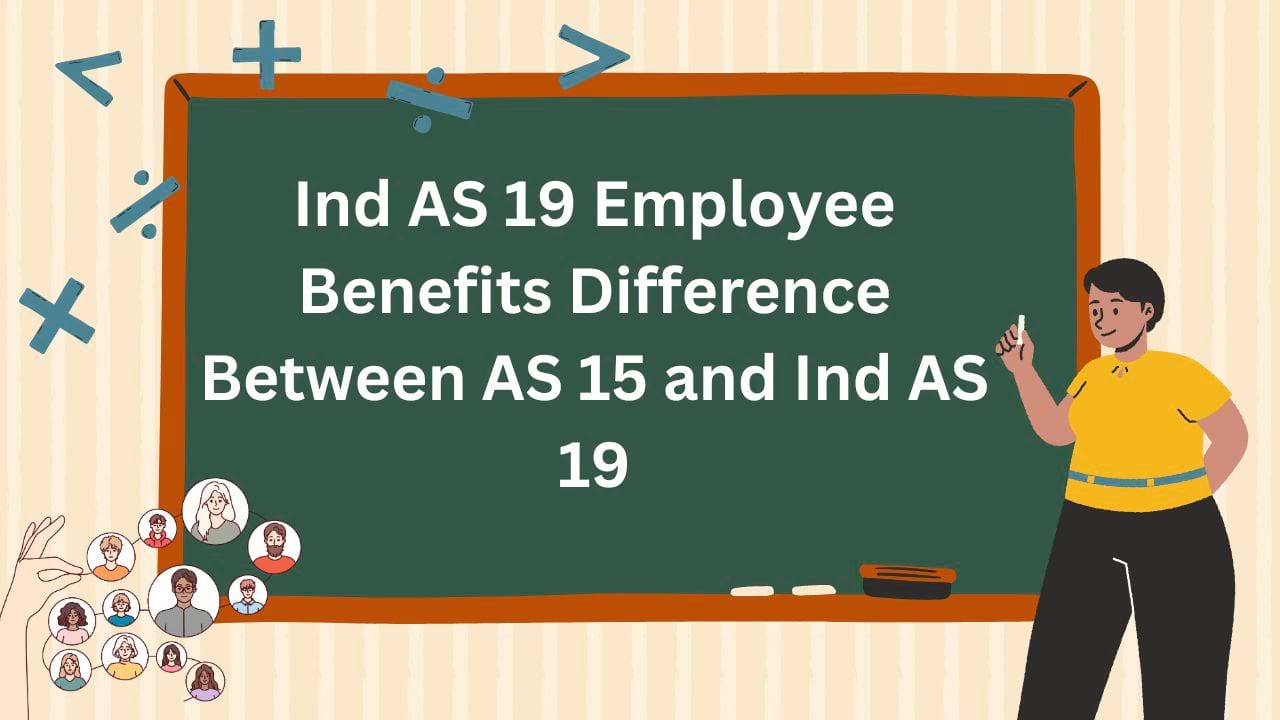Ind AS 19, Employee Benefits are all forms of consideration given by an entity in exchange for service rendered by employees or for the termination of employment.
The objective of this Standard is to prescribe the accounting and disclosure for employee benefits. The Standard requires an entity to recognize:
- a liability when an employee has provided service in exchange for employee benefits to be paid in the future; and
- an expense when the entity consumes the economic benefit arising from service provided by an employee in exchange for employee benefits.
This Standard shall be applied by an employer in accounting for all employee benefits, except those to which Ind AS 102, Share-based Payment, applies. You may also like Bills of Exchange.
Quick Links
Short-term employee benefits
Short-term employee benefits are employee benefits (other than termination benefits) that are expected to be settled wholly before twelve months after the end of the annual reporting period in which the employees render the related services.
When an employee has rendered service to an entity during an accounting period, the entity shall recognize the undiscounted amount of short-term employee benefits expected to be paid in exchange for that service:
- as a liability (accrued expense), after deducting any amount already paid. If the amount already paid exceeds the undiscounted amount of the benefits, an entity shall recognize that excess as an asset (prepaid expense) to the extent that the prepayment will lead to, for example, a reduction in future payments or cash
- as an expense, unless another Ind AS requires or permits the inclusion of the benefits in the cost of an asset (see, for example, Ind AS 2, Inventories, and Ind AS 16, Property, Plant and Equipment).
Post-employment benefits
Post-employment benefits are employee benefits (other than termination benefits and short-term employee benefits) that are payable after the completion of employment. Post-employment benefit plans are formal or informal arrangements under which an entity provides post-employment benefits for one or more employees. Post-employment benefit plans are classified as either defined contribution plans or defined benefit plans, depending on the economic substance of the plan as derived from its principal terms and conditions. Must Read Features of the Ledger Account.
Post-employment benefits: defined contribution plans
Defined contribution plans are post-employment benefit plans under which an entity pays fixed contributions into a separate entity (a fund) and will have no legal or constructive obligation to pay further contributions if the fund does not hold sufficient assets to pay all employee benefits relating to employee service in the current and prior periods. Under defined contribution plans the entity’s legal or constructive obligation is limited to the amount that it agrees to contribute to the fund. Thus, the amount of the post-employment benefits received by the employee is determined by the amount of contributions paid by an entity (and perhaps also the employee) to a post-employment benefit plan or an insurance company, together with investment returns arising from the contributions. In consequence, actuarial risk (that benefits will be less than expected) and investment risk (that assets invested will be insufficient to meet expected benefits) fall, in substance, on the employee.
When an employee has rendered service to an entity during a period, the entity shall recognize the contribution payable to a defined contribution plan in exchange for that service:
- as a liability (accrued expense), after deducting any contribution already paid. If the contribution already paid exceeds the contribution due for service before the end of the reporting period, an entity shall recognize that excess as an asset (prepaid expense) to the extent that the prepayment will lead to, for example, a reduction in future payments or a cash
as an expense, unless another Ind AS requires or permits the inclusion
of the contribution to the cost of an asset (see, for example, Ind AS 2 and Ind AS 16). You may also like Users of Accounting Information.
Post-employment benefits: defined benefit plans
Defined benefit plans are post-employment benefit plans other than defined contribution plans. Under defined benefit plans:
- the entity must provide the agreed benefits to current and former employees; and
- actuarial risk (that benefits will cost more than expected) and investment risk fall, in substance, on the entity. If actuarial or investment experience is worse than expected, the entity’s obligation may be increased
Accounting by an entity for defined benefit plans involves the following steps:
- determining the deficit or This involves:
- using an actuarial technique, the projected unit credit method, to make a reliable estimate of the ultimate cost to the entity of the benefit that employees have earned in return for their service in the current and prior periods. This requires an entity to determine how much benefit is attributable to the current and prior periods and to make estimates (actuarial assumptions) about demographic variables (such as employee turnover and mortality) and financial variables (such as future increases in salaries and medical costs) that will affect the cost of the
- discounting that benefit to determine the present value of the defined benefit obligation and the current service
- deducting the fair value of any plan assets from the present value of the defined benefit
- determining the amount of the net defined benefit liability (asset) as the amount of the deficit or surplus determined in (a), adjusted for any effect of limiting a net defined benefit asset to the asset ceiling. (Asset ceiling is defined as the present value of any economic benefit available in the form of refunds from the plan or reduction in future contributions to the plan).
- determining amounts to be recognized in profit or loss:
- current service
- any past service cost and gain or loss on
- net interest on the net defined benefit liability (asset).
- determining the remeasurements of the net defined benefit liability (asset), to be recognized in other comprehensive income, comprising:
- actuarial gains and losses;
- return on plan assets, excluding amounts included in net interest on the net defined benefit liability (asset); and
- any change in the effect of the asset ceiling (see paragraph 64), excluding amounts included in net interest on the net defined benefit liability (asset).
Where an entity has more than one defined benefit plan, the entity applies these procedures for each material plan separately.
Other long-term employee benefits
Other long-term employee benefits are all employee benefits other than short-term employee benefits, post-employment benefits, and termination benefits.
The Standard does not require the measurement of other long-term employee benefits to the same degree of uncertainty as the measurement of post-employment benefits. The Standard requires a simplified method of accounting for other long-term employee benefits. Unlike the accounting required for post-employment benefits, this method does not recognize re-measurements in other comprehensive income.
Termination benefits
Termination benefits are employee benefits provided in exchange for the termination of an employee’s employment as a result of either:
- an entity’s decision to terminate an employee’s employment before the normal retirement date; or
- an employee’s decision to accept an offer of benefits in exchange for
An entity shall recognize a liability and expense for termination benefits at the earlier of the following dates: the termination of
- when the entity can no longer withdraw the offer of those benefits; and
- when the entity recognizes costs for a restructuring that is within the scope of Ind AS 37 and involves the payment of termination benefits
Difference Between AS 15 and Ind AS 19
| AS 15 | IND AS 19 |
|---|---|
| Under AS 15, employees include Full-time directors only. | Under IND AS 19, employees include all types of directors. |
| Under AS 15, actuarial gains and losses are to be recognized immediately in the statement of profit and loss. | Ind AS 19 requires the recognition of the actuarial gains and losses in the statement of other comprehensive income. Further, the actuarial gains and losses, so recognized in other comprehensive income, should be recognized immediately in retained earnings and should not be reclassified in the statement of profit or loss of the subsequent period. |
| It does not deal with the same. | Employee benefits arising from constructive obligations are also covered. |
| AS 15 always requires the use of market yield on government bonds. | As per IND AS 19, the discount rate shall be determined w.r.t. the market yield on govt. bonds. But, in the case of subsidiaries, associates, joint ventures and branches domiciled outside India, the discount rate for calculating post-employment benefit obligation should be determined w.r.t. market yield on high-quality corporate bonds and in the absence of a deep market for such bonds, the government bonds shall be used. |
| AS 15 neither requires nor encourages the entity to involve a qualified actuary for the measurement of material post-employment benefits. | Ind AS 19 encourages but does not mandate an entity to involve a qualified actuary in the measurement of material post-employment benefit obligations. |
| AS 15 does not deal with it. | Ind AS 19 deals with situations where there is a contractual agreement between a multiemployer plan and its participants, that determines how the surplus in the plan will be distributed to the participants or how the deficit will be funded. |
| AS 15 does not contain similar provisions. | Participation in a defined benefit plan and thereby, sharing the risks, by various entities under common control, is a related party transaction for each group entity and some disclosures are required in the financial statements of such entities. |
There are differences in the following definitions between AS 15 and Ind AS 19:
| |
| AS 15 does not clarify the same. | Ind AS 19 makes it clear that the Financial assumptions should be based on market expectations, at the balance sheet date, for the period over which the obligations are to be settled. |
| More guidance has been given on the timing of recognition of termination benefits. The criteria for recognition of termination benefits is also different in IND AS 19, as compared to AS 15. |







